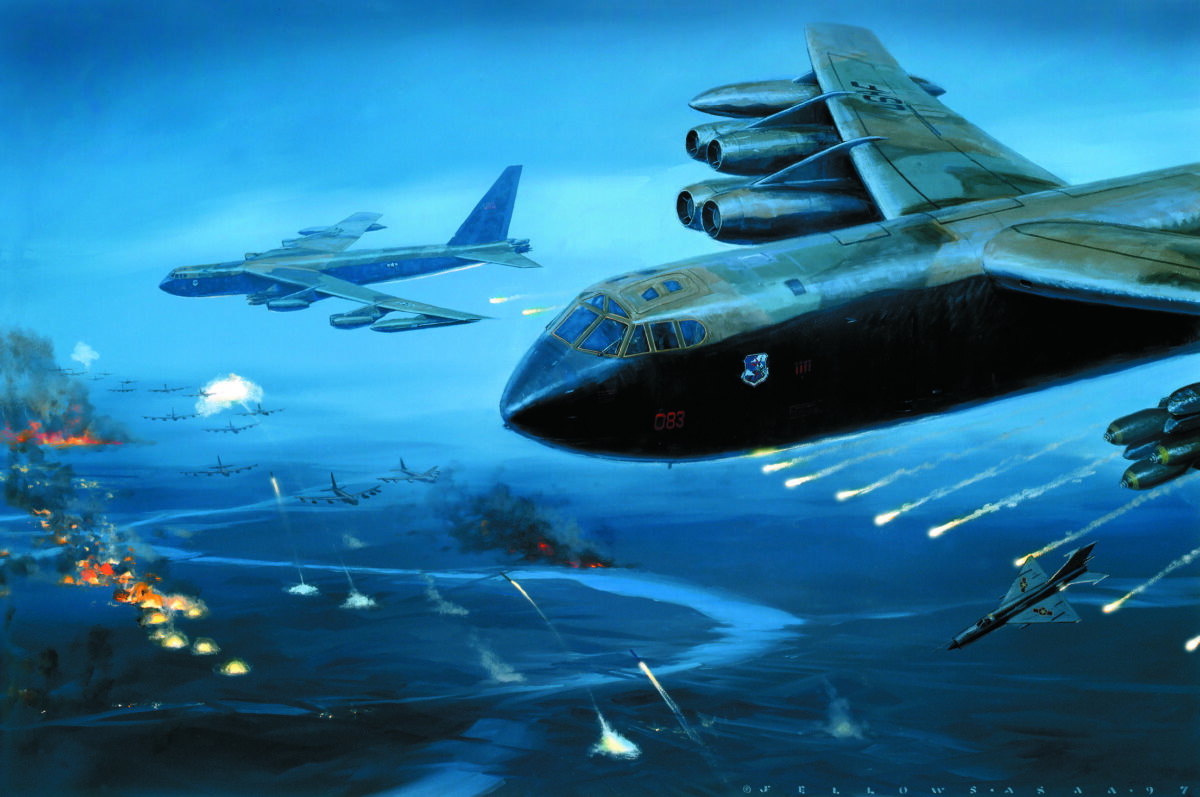The so-called Christmas Bombings in 1972 brought the North Vietnamese back to the negotiating table, but at a high cost.
Linebacker I had been mounted in response to the earlier 1972 Easter Offensive, the North Vietnamese Army’s sudden invasion of South Vietnam, a campaign that failed largely because of massive B-52 bombing. It had been hoped the war could then be concluded through diplomacy, but by mid-December it was clear the enemy was stalling at the negotiating table. Forty years ago this month, President Richard M. Nixon’s patience ran out and he issued this order to the Joint Chiefs: “You are to commence at approximately 1200 Zulu, 18 December 1972, a three-day maximum effort, repeat maximum effort, of B-52/Tacair strikes in the Hanoi/Haiphong areas. Object is maximum destruction of selected targets….Be prepared to extend operations past three days, if directed.”
The president’s directive apparently came as a surprise to Strategic Air Command, which seemingly had no contingency plan compatible with Linebacker II’s objectives. SAC was forced to fall back on its eight-year-old Operation Arc Light tactics (interdiction of the Ho Chi Minh Trail, coupled with close ground support). Tactical Arc Light operations, however, had little in common with the strategic bombing objectives of Linebacker II. Worse, after eight years of Arc Light operations in relatively benign threat environments, SAC HQ had become complacent about the dangers in Route Pack Six, the section of the combat theater encompassing Hanoi and Haiphong. This last circumstance led to a rude awakening when America’s B-52 Stratofortress bombers proved shockingly vulnerable to the Soviet-built SA-2 Guideline surface-to-air missile (SAM) defense system.
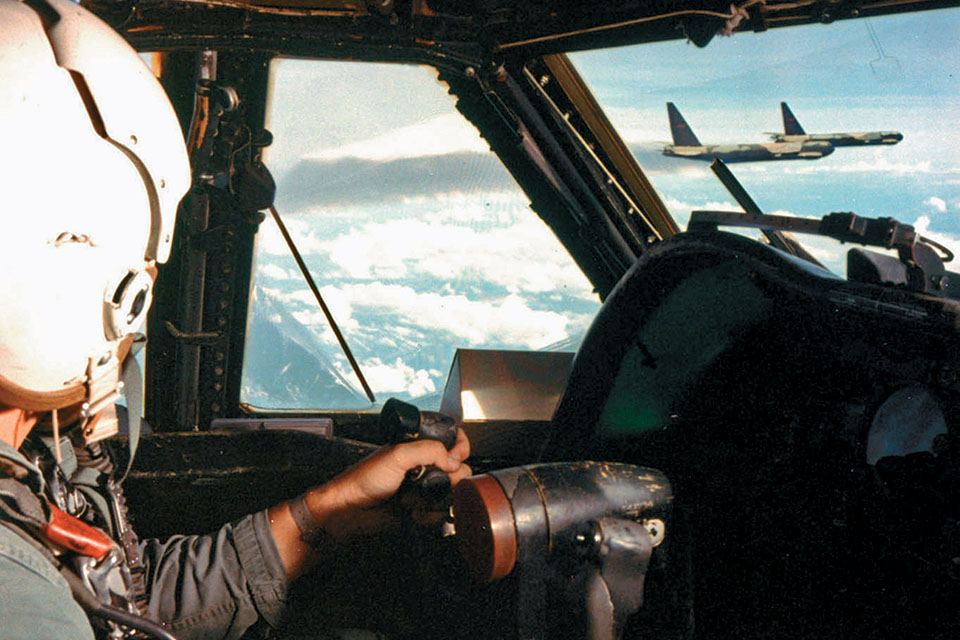
The enormity of SAC’s planning errors was first exposed during the Day One (December 18-19) briefing at Andersen Air Force Base on Guam. The BUFF (Big Ugly Fat F—er) aircrews, still half-believing Secretary of State Henry Kissinger’s “peace is at hand” rhetoric of several weeks earlier, sat in stunned silence as the briefing officers flashed the primary target on the screen: Hanoi. Adam’s apples bobbed even faster when it was announced that “press-on rules” were in effect: “All bombers will press on, despite SAMS, MiGs or flak, if there is a reasonable chance to strike the target and recover at an allied base.”
There was worse news—the attack tactics themselves. All bombers were to depart from the same initial point (IP), make the same bomb run in single-file formation, fly exactly the same airspeeds, operate in exactly the same altitude blocks and maintain exactly the same spacing between each of the three-ship cells (one minute) and between each aircraft within the cells (15 seconds).
A B-52 copilot who flew Linebacker II sorties from Andersen, then-Captain Don Craig, wrote me that “We knew there were big planning flaws, starting with the long lines of bombers coming in the same route…and it was straight down Thud Ridge, for God’s sake….It looked very much like ducks in a shooting gallery.” B-52 radar navigator Captain Wilton Strickland, operating from the other B-52 base, at U-Tapao airfield in Thailand, concurred: “[The spacing] gave enemy air defenses plenty of time to track and fire on each aircraft as it came within range….Long before we entered the target area, they knew our precise altitude, spacing and approach route….”
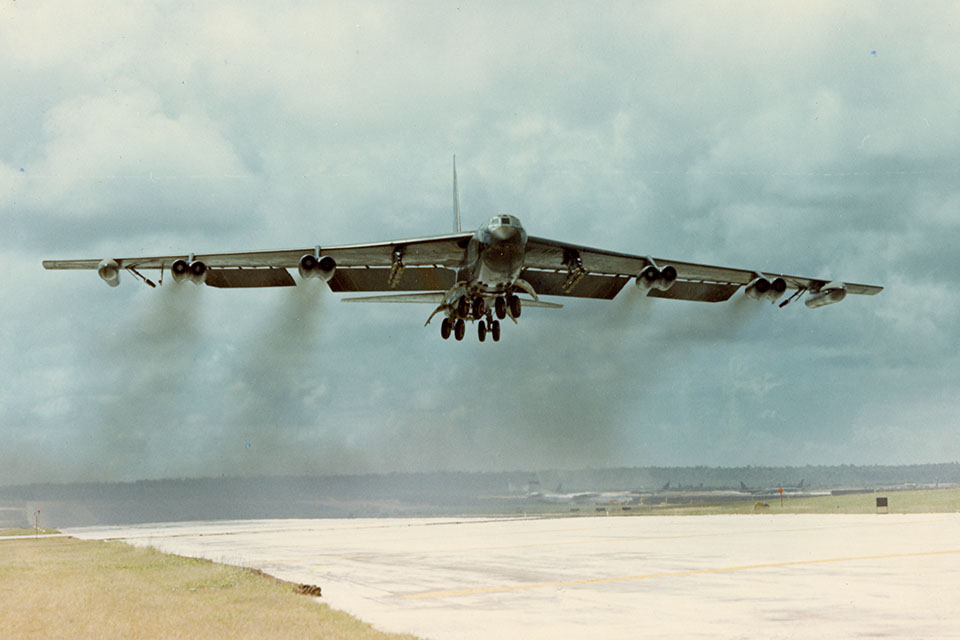
Another concern was the bomb run no-evasion order issued by an Andersen wing commander (apparently on his own authority, on penalty of court-martial), despite previous evidence that if the B-52 was brought back straight and level prior to release, accuracy was not degraded. After aircrews repeatedly ignored the order on Days One and Two, without affecting bombing results, it was quietly rescinded.
Most egregious, SAC planners mandated a “combat break” to the right after bomb release (post-target turn, or PTT), a nuclear-release procedure carried over into Arc Light (where it had been just as pointless; the PTT was designed solely for better survivability against a nuclear blast). During Arc Light, the PTT had rendered no harm. Over heavily defended Hanoi, however, it turned lethal. Not only were critical electronic countermeasures degraded, the 120-knot-plus jet stream tailwind that B-52s enjoyed on the bomb run became a 120-knot-plus headwind after the turn, resulting in a combined groundspeed reduction of nearly 250 knots.
Later, during the Day Two pre-mission briefing, a disgusted Captain Strickland, who was destined to fly six of the 11 Linebacker missions, could no longer keep silent: “Who is planning such stupid tactics,” he asked the briefers, “and why?” Their response: “The planning is being done at Omaha’s SAC HQ, and the common routes, altitudes and trail formations are used for ease of planning.”
“Well,” Strickland shot back, “the enemy is using your plan, along with the after-release turn and our slow withdrawal, for ease of tracking and shootdown!”
U-Tapao’s 17th Air Division commander, Brig. Gen. Glenn Sullivan, who was present during Strickland’s comments, was thinking along similar lines. Sullivan and his wing commanders had been carefully listening to aircrew feedback, though their requests for tactics changes had so far fallen on deaf ears. Sullivan was most upset about the PTT; after the battle he wrote a friend, “The post-target turn was the murder point.”
Nevertheless, good tactics or bad, the 300 BUFF in-theater aircrews still had to fly the missions in the 206 Stratofortresses available (Andersen had 53 B-52Ds and 99 B-52Gs on station; U-Tapao had 54 B-52Ds). On Day One, 129 B-52s launched from Andersen and U-Tapao in three massive waves spaced at four-hour intervals. Shortly after dark, the first wave (33 B-52Ds and 15 B-52Gs) arrived at their Laotian IP and wheeled southeast toward seven Hanoi targets—setting the stage for the biggest air battle since World War II. Although the BUFFs were the attack’s centerpiece, more than 100 additional U.S. Air Force, Navy and Marine recon, radar jammer and fighter-bomber aircraft flew in support of the heavies or delivered their own assigned blows.
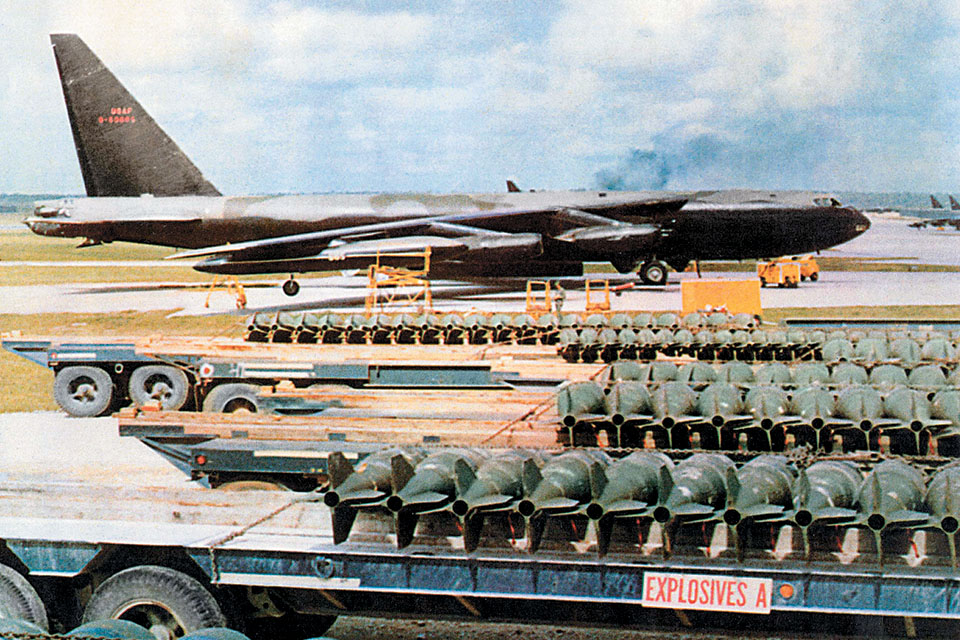
Twenty-one U-Tapao B-52Ds kicked things off, attacking Hanoi’s airfields. At least one MiG rose up in challenge, the enemy pilot taking up the customary “six” position behind a BUFF designated Brown Three. Tail gunner Staff Sgt. Sam Turner shot the MiG-21 down, the first ever air-to-air kill by a B-52. Shortly thereafter, Lilac Three was struck by a SAM while attacking the Kinh No complex. Although badly damaged, the bomber managed to limp back to U-Tapao. Charcoal One, a B-52G attacking the Yen Vien rail yards, was not as fortunate. Two SAMs struck from behind, and the bomber disintegrated. Three crewmen were killed in action; three became prisoners of war.
The second wave attacked around midnight. Peach Two entered the PTT and, slowed to a near-crawl by the 120-knot headwind, took a SAM hit in its left wing. The bomber made it back into Thailand, where all seven crew members bailed out and were rescued.
Rose One, a U-Tapao B-52D, led the third wave of 51 BUFFs in at 5 a.m. Bracketed by missiles, its jammers overwhelmed, the plane was hammered twice. One SAM blew a hole in the fuselage big enough for the navigator-bombardiers to see the external bomb racks. Moments later the cockpit was afire. Four crewmen were captured, with two KIA.
Day One ended with three Stratoforts shot down and two seriously damaged. Publicly, SAC put on a brave face; privately, its chieftains were aghast. They had completely underestimated the SAM threat. Worse, nothing could immediately be done about it—because of the long distances involved in operating from Guam, it had been necessary to order the Day Two bombers launched even before all the Day One aircraft returned.
On Day Two, 93 BUFFs attacked the same targets, using the same Day One tactics. Ivory One, piloted by Major John Dalton, led six B-52Ds against Radio Hanoi. While rolling into the PTT, his aircraft was struck by a missile, seemingly stopping the bomber in its tracks. “You could feel the concussion,” he told writer Marshall Michel, “then you heard it. I never realized you could hear them explode like that…you get static electricity raising the hair on your arms….” Dalton was in big trouble—his no. 5 engine had flamed out, then no. 6 caught fire. Both tip tanks were hit and spewing fuel, plus he was dealing with severe electrical and flight system problems. For 45 nerve-wracking minutes the crew staggered toward the Marine Corps base at Nam Phong, Thailand. Just before touchdown, Dalton lost most of his rudder control. Pulling the last rabbit out of his hat, he planted that giant BUFF on a narrow runway, saving the aircraft and crew. Major Dalton was awarded the Silver Star for his actions.
Meanwhile, Strickland and his crew in Copper Two were pressing on against Radio Hanoi. Thirty seconds from release, Strickland’s electronic warfare officer (EWO) called, “SAM uplink!” A missile had them wired. Then the copilot yelled, “Visual SAM at 2 o’clock, I have the airplane!” and threw the big bomber into a steep right turn. There was a bright flash, a muffled explosion and the aircraft lurched, as if driving over a speed bump. EWO again: “SAM uplink, 9 o’clock!” The pilot responded: “Visual SAM to left, I have the airplane!” A hard steep left turn followed. Bright flash, another lurch. Somehow Strickland kept his crosshairs on Hanoi’s Paul Doumer Bridge, the offset aiming point. “Pilot, roll it out,” he ordered. “Center the PDI [pilot’s deflection indicator]!” The nav read the To Go (TG) meter, announcing, “10 seconds!” Strickland opened the bomb bay doors. The EWO cried out, “Two SAM uplinks, 12 o’clock!” Strickland responded, “Pilot, hold it straight and level!” The two missiles continued to home in on Copper Two. After what seemed an eternity, the TG ran down to zero. “Bombs away,” Strickland shouted, “and turn! Let’s get the hell out of here!” Another hard, shuddering right turn; the two SAMs just missed them. For their actions, all six crewmen received the Distinguished Flying Cross.
The Americans were lucky on Day Two: Only two B-52s were damaged and none lost. Breathing easier, SAC gave the go-ahead for Day Three, December 20-21, once again ordering up the same tactics as Days One and Two. But the inevitable bill had finally arrived; the Americans were about to face their darkest hour.
Ninety-nine B-52s struck on Day Three. Enemy SAM batteries, having at last figured out how to destroy the hated “Fatted Calves,” waited eagerly for the first wave to appear. As if on cue, the three bombers in Quilt cell arrived over the Yen Vien complex in their B-52Gs. (While the Arc Light B-52Ds had been refitted with the most up-to-date ECM jammers to counter Hanoi’s highly sophisticated air defense system, there had not been time to do the same with the U.S.-based Gs when they were rushed into the war during the 1972 Easter Offensive.) A missile promptly nailed Quilt Three during its PTT. Four crewmen became POWs, and another two were KIA.
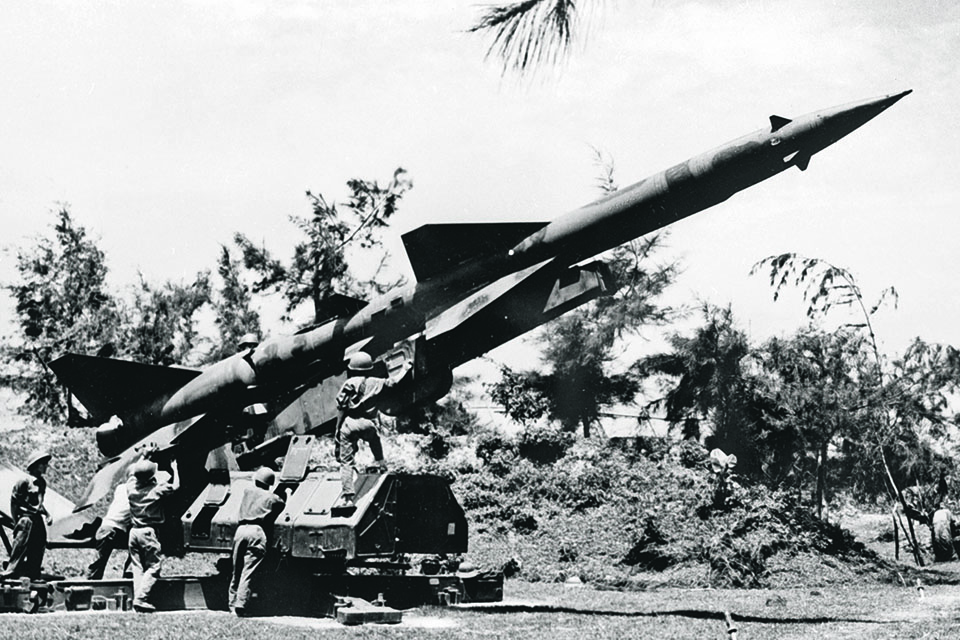
Shortly thereafter, during yet another harried post-release turn, Brass cell became separated. The enemy seized on the cell’s abrupt loss of groundspeed, its prominent radar return in the steep turn and collapse of mutual support radar jamming. Two SAMs slammed into Brass Two; miraculously, the entire crew successfully bailed out over the Marine base at Nam Phong. Orange Three also became isolated in its PTT and was nailed by two missiles. The aircraft fluttered out of control, exploded halfway to the ground and crashed spectacularly near Hanoi. Four crewmen perished and two became POWs—the last of the first wave casualties.
At roughly this point, a curious incident occurred. R.J. Smith, a grizzled electronic warfare officer credited with 506 Arc Light/Linebacker combat missions (possibly the record), took matters into his own hands. Configuring his countermeasures equipment just so, he hacked into the North Vietnamese ground control intercept network, whipped out his “lucky” whistle and let fly with a blast over Guard frequency—followed by an angry shout: “Time out!” Perhaps Smith’s unorthodox actions did confuse the enemy; there was an obedient pause in the SAM launches, and his crew successfully completed their bomb run. One thing was certain: EWO stock shot up to all time highs!
By that time, 27 second wave bombers were well on their way inbound, 12 of which were B-52Gs. While six of those Gs had some updated jamming equipment, the other six didn’t. With the hot Hanoi kitchen burning up the G-model birds, SAC pulled the plug by recalling the six unmodified Gs. The remaining six Gs and 15 Ds in the second wave unloaded on their targets and escaped without losses.
Four hours later, wave three attacked Hanoi’s Gia Lam rail yards. A SAM slammed into Straw Two, wounding the pilot and navigator. The tough B-52D managed to reach Laos, and five of its crew survived, but the radar nav was lost. Olive One was later hit over Kinh No repair complex during its post-release turn. Five of the seven crewmen were KIA; two became POWs. Minutes later, Tan Three took two SAMs, disintegrating so rapidly only the gunner survived. Brick Two, at the tail end of wave three, was in its PTT when a missile ripped into it. The D shook the hit off and got home, but that was the final straw: B-52 aircrews wanted nothing more to do with SAC’s deadly post-release turns.
Out of Day Three’s 99 bombers, four Gs and two Ds had been shot down, with another D seriously damaged—7 percent attrition, a completely unsustainable rate. The battle, indeed the war itself, suddenly hung in the balance. Great consternation gripped the leadership of both SAC at Omaha and the Eighth Air Force at Andersen. Fearing this indecision had created a leadership vacuum, U-Tapao’s General Sullivan made a risky decision. Without consulting his immediate superiors, he sent an urgent message directly to SAC commander in chief General J.C. Meyer in Omaha (copying Andersen), specifying the necessary changes: Vary the inbound routes and altitudes, eliminate the PTT and use a straight-ahead “feet-wet” exit out to the Gulf of Tonkin. Although angry at being bypassed, his Eighth Air Force commanders sent a “we agree” message to Meyer, who quickly ordered the changes. (Sullivan must have understood he’d fallen on his sword; despite his leading role in winning the war’s decisive battle, he was denied a second star and retired two years later.)
But how to implement those changes without creating an even bigger disaster? The size and scope of Linebacker II had given it an almost unchangeable momentum—even as Meyer made his decision, it was already bus time for Andersen’s Day Four crews.
Desperately short of options, SAC held back all Andersen bombers on Days Four and Five, buying time for essential analysis and planning. On Days Four through Seven, only 60 of the better-equipped B-52Ds were launched against North Vietnam (the more vulnerable Gs would never again be used over Hanoi).
Despite launching a much higher percentage of D models, BUFFs were still going down. On Day Four, while attacking Bac Mai airfield, Blue One was bracketed by a six-SAM salvo. With his aircraft burning fiercely but nearing “bombs away,” pilot John Yuill reluctantly hit the red abandon light. That intuitive decision proved providential; roughly a minute after the last crewman had bailed out, the aircraft exploded. Although several of the captured crew were wounded, all survived the war.
Day Five was a repeat of Day Four—though the attack shifted away from the crack Hanoi SAM batteries. U-Tapao sent up 30 B-52Ds against the less heavily defended but still lucrative targets at Haiphong Harbor—primarily railroad infrastructure and petroleum facilities. Only 43 SAMs came up, thanks to the element of surprise and excellent suppression work by 65 Navy, Marine and Air Force fighter/jammer aircraft. For the first time since the operation began, not a single B-52 received battle damage.
On Day Six, 30 bombers launched, 12 Ds from Andersen and 18 Ds from U-Tapao. The targets were three SAM sites and Haiphong’s Lang Dang rail yards. Again, the objectives were successfully struck, with no losses or aircraft damaged. SAC was finally getting its act together.
On Day Seven, 30 Ds launched against Hanoi, bombing the Thai Nguyen and Kep railroad yards. No aircraft were lost, though one was struck by flak, the only occasion enemy AAA scored a hit. MiGs engaged Black and Ruby cells; one bogey got careless behind Ruby Three and was shot down by Airman 1st Class Albert Moore, the second and final confirmed MiG kill by a B-52 tail gunner. As the last of the Day Seven bombers landed, the obligatory Christmas pause got underway.
SAC used that 36-hour reprieve to develop a comprehensive new battle plan. Day Eight, December 26, was to be the decisive engagement. That night 120 B-52s struck Hanoi and Haiphong in a simultaneous attack involving seven waves bombing 10 targets, with bombers crisscrossing at different altitudes and axes of attack. American ECM capability, long a chronic deficiency, had been significantly enhanced via greater knowledge of enemy frequencies and techniques. Most dramatically, all 8,000 bombs were released during a single 15-minute timeframe.
Nevertheless, the North Vietnamese fought back hard. Shortly before bombs away, a missile struck Ebony Two, killing the pilot, though the copilot and radar nav held everything together through the bomb drop. Then another SAM struck. With unmistakable finality, Ebony Two flipped on its back and turned supernova, lighting up the sky for 100 miles in every direction. Thousands of gallons of burning JP-4 hung in the sky as if suspended, while shattered remnants of the great ship slowly fluttered to earth like dead leaves. Two crewmen were KIA; four became POWs.
Minutes later, Ash One’s jamming came up short and it took a missile. The crew made a valiant attempt to land their crippled B-52D at U-Tapao, but lost the struggle when an attempted go-around resulted in a departure stall. Only the gunner and a wounded copilot survived the ensuing crash. Nearly three decades later that same copilot, Defense Intelligence Agency analyst and retired Lt. Col. Robert Hymel, was killed when hijacked American Airlines Flight 77 crashed into the Pentagon on September 11, 2001.
SAC made Day Nine a repeat of Eight, albeit a scaled-back version. Due to maintenance issues, Andersen and U-T could raise only 30 bombers each—but halving the force didn’t have as great an impact as might be presumed: SAC was already running out of targets.
December 27 was the final day of SAMs coming in salvos, though the BUFFs were not out of the woods yet. Cobalt One was releasing bombs on its Trung Quang target when it took a direct hit that killed the navigator and the EWO. The remaining four crewmen would be captured.
Soon after that Captain John Mize in Ash Two, whose aircraft had already been hit by enemy fire on two previous sorties, was struck by a missile, the detonation wounding everyone on board. Despite Mize’s wounds and severely damaged aircraft, he somehow manhandled the doomed bomber into Laos, electing to stay with it until his entire crew had successfully bailed out before ejecting. For his heroism, Mize was awarded the Air Force Cross.
Day Ten arrived, and only a few SAMs came up; no B-52s were lost or damaged. Everyone took pleasure hearing the last of the airborne commander’s exit roll call:
“Orange cell, out with three.”
“Quilt, out with three.”
“Violet, out with three.”
On Day Eleven, December 29, 60 B-52s attacked Hanoi’s storage facilities and what was left of the Lang Dang rail yards—in all probability the last massed heavy bomber strike the world will ever see. While the raid was in progress, the North Vietnamese signaled the White House that they were ready to return to the Paris peace table. Before the last B-52 landed, Operation Linebacker II stood down.
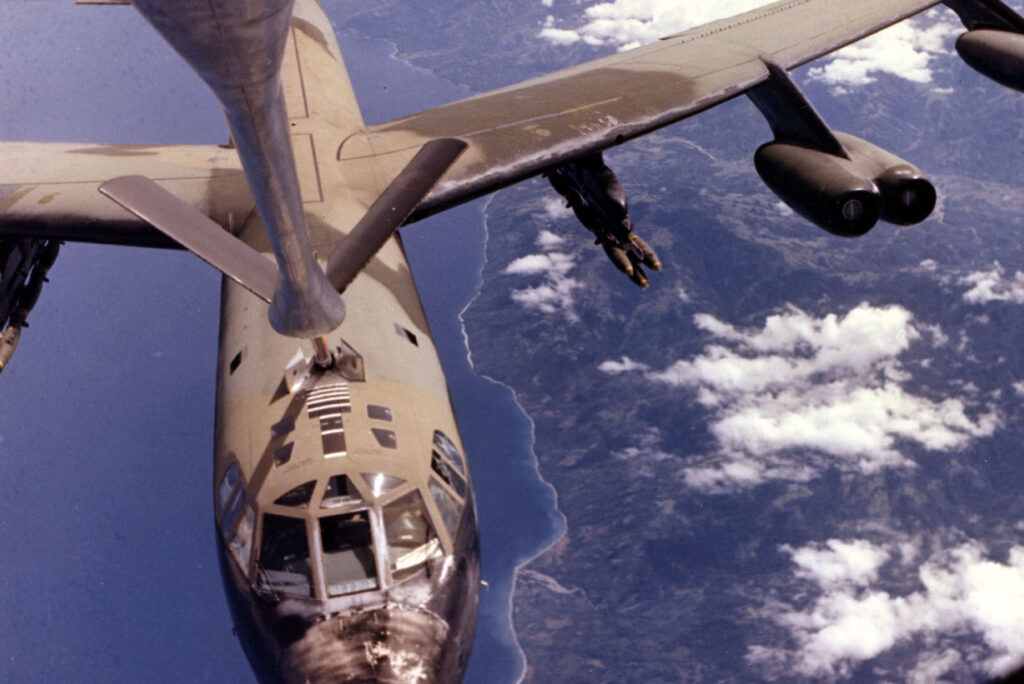
President Nixon’s 11-Day War had paid off. As is so often the case with armed conflict, the battle may have turned on circumstances no one could possibly have foreseen. North Vietnam made the crucial mistake of gathering all its eggs in one basket; the final defense of its homeland had been left primarily to a limited supply of Soviet SAMs. In the heat of battle, the North Vietnamese then compounded that error by succumbing to zeal and expending missiles wholesale, often in salvoes of six or eight against a single target. As a result, they literally ran out of ammunition. In a final irony, a chilling argument can be made that SAC’s poor tactics—in essence using the B-52s as “missile bait”—had actually worked to the Americans’ advantage.
The Paris Peace Accords were signed in January 1973. By April all 591 of America’s known POWs were released. That August, with the Paris agreements seemingly being honored by Hanoi, the B-52s flew their last combat mission, and Operation Arc Light was terminated. For the Americans, the Vietnam War was finally over.
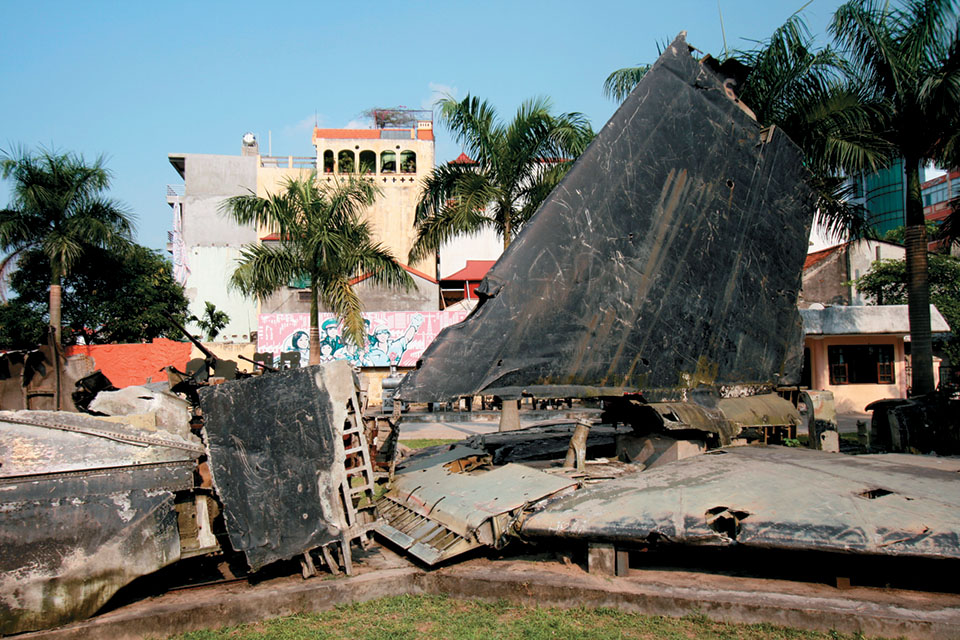
Six B-52s suffered minor hits, three were seriously damaged and 15 lost during the December 18-29, 1972, battle. Of the 92 BUFF crewmen shot down, 26 were rescued, 33 were captured and 33 were killed. (Two other B-52s were shot down just before and after the battle, with all 12 men rescued.) Additional U.S. Air Force, Navy and Marine losses included two Navy A-6A carrier strike aircraft, one Marine A-6A, one Navy A-7C, one Navy A-7E, one Marine F-4J carrier fighter, one Navy RA-5C recon aircraft, two Air Force F-111A fighter-bombers, two Air Force F-4E fighter/chaff sowers, one Air Force EB-66 ECM/chaff sower and one HH-53 Jolly Green Giant rescue helicopter. Two of these aircraft were lost to SAMs, three to MiGs, three to flak, one to small arms (Jolly Green), one to engine failure (EB-66) and three others to unknown causes. Among their crews, two were rescued, eight captured and 11 KIA—with possibly two additional unknown KIAs in the EB-66.
Robert O. Harder flew 145 combat missions in Vietnam as a B-52D navigator-bombardier. For further reading, see his book Flying From the Black Hole: The B-52 Navigator-Bombardiers of Vietnam; The 11 Days of Christmas, by Marshall Michel; and Boeing B-52, by Walter J. Boyne. An online cockpit audiotape offers a ringside seat to the December 26 raid. Go to YouTube and search “B-52 Over Hanoi” for five separate links.
This feature originally appeared in the January 2013 issue of Aviation History. For more great articles subscribe today!

